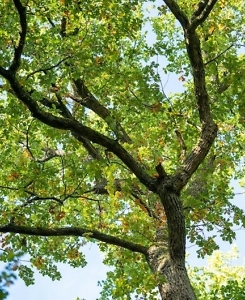Confessions of the Tree Survey
Facing memories of trees lost
We were never good yard people, learning about tree diseases and insect infestations only when it was too late and the county extension agent explained that the magnolia tree was dying. Even as the somber young man spoke what amounted to last rites, the tree continued its pattern of producing oxygen and protecting the birds. Magnolia trees symbolize good fortune and stability, but ours had run out of luck, and not long after the agent’s visit, we had to cut it down. In the tree’s seasons of health, we had admired its glossy leaves and star-shaped flowers, and we hid Easter eggs under the boughs for our daughters to collect.

It was not a balanced relationship, and though the tree deserved better, I did not notice when tiny magnolia scale pests began crawling across the bark, a time when intervening with chemical sprays, insecticidal soaps, or horticultural oils could have made a difference. This unlucky tree was not the only one growing in our yard that we took for granted. Early on, there were excuses for our inattentiveness. While busy raising little humans, our outdoor experiences centered on setting up a trampoline and playhouse. Though my husband and I had more free time as the children grew up, we never worried over the plants, instead appreciating nature’s independence when birdseed spilling from the feeder grew into a lovely patch of amber-colored grasses. Wild and beautiful, they made a fine show and needed no pruning. For years, our half-acre lot carpeted with Bermuda and sprinkled with trees was mostly a place for cookouts and conversation around the fire pit.
Many backyard gatherings later, the 2025 Tennessee Tree Survey was delivered to our mailbox, addressed to our 23-year-old daughter, who was willing to help with data collection concerning her parents’ tiny portion of the urban forest. Its questions connected her with happy memories, and one inquired, “Have you ever climbed a tree?” Yes, she had giddily scrambled at least halfway — maybe even three-quarters — up a tree. “When you were a child, did you ever play under or amongst trees?” Indeed, she had played with her dolls in the trees’ shade. “Did you ever collect leaves, acorns, or pinecones for a school project— or just for fun?” She fondly remembered many of those projects.
The survey also posed more global questions, including “How do you think Tennessee has done on conservation in the past year?” Our daughter picked “not sure.” “On a scale of 1-10, how important do you think it is to replenish the trees in America’s forests?” It’s of high importance, she answered.
Finding the survey on the kitchen counter, I faced memories of trees lost, and admitting to the small number of living trees struck me as a form of confession. Twenty years earlier, our suburban house came with five trees in the front yard and a giant oak growing in the corner of the backyard. The first year, a storm blew in and ravaged one of the three Bradford pears in the front yard. Lovely and fragile, with white flowers in spring and attractive fall foliage, it was planted by a home builder for instant landscaping. Other storms followed, eliminating the remaining Bradford pears. To make up for the losses, my daughters surprised me with a Japanese maple tree for Mother’s Day, and we enjoyed planting it together in the backyard.
Now as I looked over the survey, I recalled the intrusive roar of the trains when we first moved into the neighborhood. The blasts came day and night, and as I learned to push the noise to the background, the sound did not disturb me at all. In a similar way, the trees stayed on the distant perimeter of my life. I paid scant attention to their health, assuming that they would always exist and thrive. Like the magnolia, the massive oak tree near the back fence was assumed to be strong and permanent, though oak wilt disease was attacking its roots. We did not notice the signs of discolored leaves and a thinning crown. Then, one night as our family slept, the tree succumbed to its disease, toppling over chairs near the fire pit.
To the end, the tree was altruistic, dropping in the night and protecting family members who often gathered around the fire pit during the day. In a touching final act, the oak did not even damage the house’s roof, resting its crown on the gutter because its frame perfectly corresponded with the yard’s length. Confused squirrels sought out their favorite hiding places as they scampered across the downed trunk. The five dead trees had been a generous cornucopia, providing oxygen, removing carbon dioxide to slow climate change, and offering habitat for birds and animals, and each deserved a celebration of life service honoring their beneficence.
By now, we know the county extension agent well, his young face again sorrowful as he makes another house call. He gives the single tulip poplar tree left in the front yard a poor prognosis, but we hang onto it because to slice it down would leave a stark, terribly bare space, and it continues to generously cool the house. For now, bluebirds can fly east from this tulip poplar to a majestic oak planted before the Civil War that stands on a local elementary school’s campus. There, young children have a chance to play games beneath a tree that has endured. Parents who may one day buy our house will need to plant new trees if they want their children to play games in a shady spot, though the Arbor Day Foundation is providing us with a starter pack. In return for completing the survey, and in exchange for a small donation to the foundation, my daughter will receive 10 flowering trees specially selected to thrive in the Memphis area. My husband and I will help with planting the 6- to 12-inch trees, driven by something more than enthusiasm for gardening or need for approval from the neighbors. No longer can the trees in our sliver of urban forest be overlooked. Every few months, I will circle the yard, take notes, and monitor their health. The fight is on to restore what was lost.
Copyright © 2025 by Stephanie Painter. All rights reserved.

Stephanie Painter works as a freelance writer and is the author of a children’s picture book. She lives in Germantown and writes for regional magazines.


